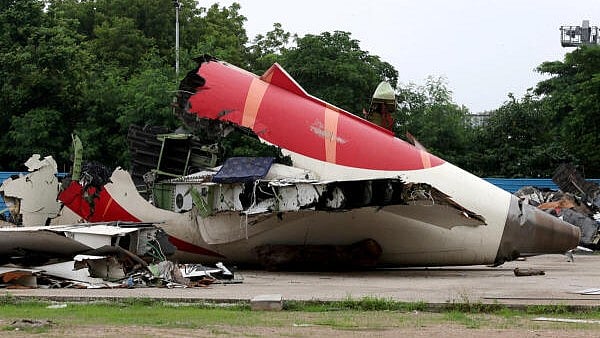
Wreckage of the Air India Boeing 787-8 Dreamliner plane sits on the open ground, outside Sardar Vallabhbhai Patel International Airport, where it took off and crashed nearby shortly afterwards, in Ahmedabad.
Credit: Reuters Photo
The preliminary report of the Aircraft Accident Investigation Board (AAIB) on the AI 171 accident was released just before midnight on July 11, minutes before the 30-day period stipulated in Annex 13 of the Convention on International Civil Aviation ended. India, as the State of Occurrence, had the primary responsibility to produce the report within 30 days of the accident. Awkward questions have been raised about the report itself, also about DGCA’s fault lines, Air India’s practices and processes, and Boeing’s systemic failures and miscarried accountability.
First, the report itself. It quotes the International Civil Aviation Organisation (ICAO) in its foreword thus: “the sole objective of the investigation of an Accident/Incident shall be the prevention of accidents and incidents and not to apportion blame or liability”. However, it insinuates that the fuel control switches were “transitioned” to the off position three seconds after take-off. This vague statement led to experts commenting in the media that the captain could have consummated an expensive and deadly suicide. Although this theory was contended against by the majority of the aviation community, the report’s wording is to be blamed for the suicide conjecture. A related fact is that the report was leaked to The Wall Street Journal more than 44 hours before it was made public at an unearthly hour in India. The US media was hinting at the suicide angle almost two days before the report was available in India. That the case involved Boeing, a US-based aircraft manufacturer, is crucial.
The report does not give a clear picture of which pilot asked why the fuel control was switched off. Pilots need to mandatorily wear their headsets during take-off; the implication is that the CVR records, electronically and disparately, the voices of the left and right seat occupants of the cockpit. Then why the mystery over which pilot said what? Moreover, it is inconceivable that, besides the exchange on fuel cut-off switches, there was no significant conversation in the cockpit. Why the secrecy on that count?
The accident has also placed DGCA in the limelight. Its oversight, according to some analysts, remains inadequate to India’s burgeoning civil aviation. Understaffing and lack of freedom have been its bane for long. Occasional proposals by the industry and the aviation community to make it an independent, autonomous body, like the UK’s Civil Aviation Authority, have not been heeded by the government.
DGCA operates under the Ministry of Civil Aviation (MoCA) with limited financial autonomy and staffing flexibility. Even the AAIB, carved out of DGCA in 2012, is an ‘attached office’ of the same ministry, and does not have any pilots on its roll. Significantly, DGCA has
ordered all airlines to inspect the lock on the fuel control switches on Boeing 737 and 787 aircraft by July 21. The check was flagged as a potential disengagement of the switch back in 2018 by the
US Federal Aviation Administration (FAA), but was advisory and hence not mandated by DGCA.
Systemic flaws
When the Tata Group took over Air India in 2022, public perception and expectation were for a complete overhaul of the airline’s ethos. However, it has been harder than expected to combat well-entrenched indolent practices, institutionalised unionisation, and low productivity.
The AI 171 accident has somewhat sullied the airline’s rejuvenative endeavour and cast a shadow over its maintenance practices and oversight. But it may be mentioned here that the entity which carries out the maintenance of Air India’s aircraft – AI Engineering Services Limited (AIESL) – is owned by AI Assets Holding Company Limited, a Public Sector Undertaking of the Government of India.
The 787 Dreamliner has been flaunted as one of the world’s most technologically advanced long-haul aircraft. Since its debut in 2011, it has operated without any major accidents. Notably, after the AI 171 accident, the US FAA has not ordered a grounding of the 787 fleet.
Fingers have been pointed at Boeing over its apparent precedence to profit for shareholders over the safety of passengers. Whistleblowers within Boeing (notably John Barnett and Sam Salehpour) have occasionally raised concerns about quality control problems and production standards – some of them have even claimed that the design had potentially dangerous flaws.
The ICAO Annex 13 allows the preliminary report to be either confidential or public (only the final report is required to be made public). With the benefit of hindsight, it appears that the AI 171 preliminary report would have been better off under wraps than exposed half-heartedly to an incisive media and an intelligent public.
(The writer is a former COO of an airline)